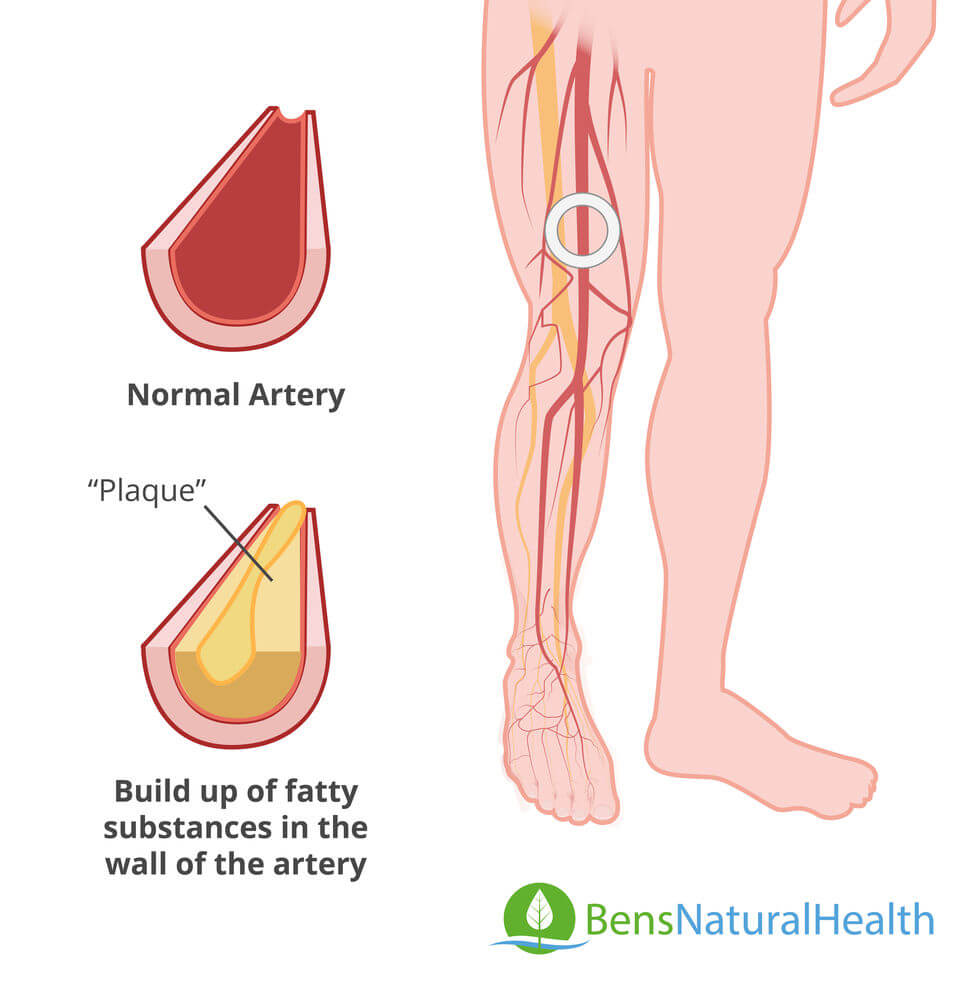- What Is Peripheral Artery Disease?
- Symptoms Of Peripheral Artery Disease?
- What Parts Of The Body Does Peripheral Artery Disease Affect?
- Peripheral Artery Disease Test
- Causes Of Peripheral Artery Disease
- What Is The Typical Prognosis For Peripheral Artery Disease?
- How Can Peripheral Artery Disease Be Prevented?
- Who Is Most At Risk For Peripheral Artery Disease?
- Treatment Options for Peripheral Artery Disease
- How Is Peripheral Artery Disease Treated?
- What Dietary And Lifestyle Changes Are Recommended For Someone Suffering From Peripheral Artery Disease?
- What Happens If Peripheral Artery Disease Goes Untreated?
- Best Supplements To Help Peripheral Artery Disease
- Source
Arteries play a major role in the blood circulatory system. This system uses arteries to transport blood throughout the human body.
Blood is enriched with both oxygen and essential nutrients that all tissue in the body relies on.
When problems develop with the arteries, blood flow may be reduced. This can cause a person to experience several adverse effects.
In some cases, these issues can lead to potentially life-threatening complications.
Peripheral artery disease is one condition that is known to cause complications that can put a person’s life in danger.
Understanding how the disease works is important. Individuals should also understand the symptoms and causes.
This post digs deeper into this condition. We also consider potential treatment options.
A few natural remedies are also shared to improve blood flow and reduce the effects of this disease.
Get Your FREE Diabetes Diet Plan
- 15 foods to naturally lower blood sugar levels
- 3 day sample meal plan
- Designed exclusively by our nutritionist
What Is Peripheral Artery Disease?
Peripheral arterial disease is a condition that has a direct effect on blood vessels and arteries in the patient’s body.
Sometimes also referred to as peripheral vascular disease, individuals who develop the condition will experience a reduced blood flow. This is due to the build-up of plaque in the blood vessels in the individual’s body.
The plaque that accumulates in arteries consists of various materials. These materials generally include:
- Fat
- Cholesterol
- Fibrous tissue
- Calcium
Other substances may also collect and form plaque. The plaque makes it difficult for blood to flow through these vessels. This can deprive tissue in some areas of the body from oxygen and nutrients.
The result may be a reduction in cellular function. There are also other complications associated with this reduction in blood circulation.
People with peripheral artery disease are also at risk of other conditions. This includes coronary artery disease. The person may also develop other types of heart disease. The condition may also be among the risk factors for high blood pressure.

Symptoms Of Peripheral Artery Disease?
Symptoms associated with peripheral artery disease are sometimes referred to as intermittent claudication.
This usually includes leg pain. The pain may also affect the feet, calves, thighs, and buttocks. Cramping may accompany the pain. Resting may help to reduce the severity of these symptoms.
Other symptoms may occur. These can include:
- Weakness in legs and feet
- Lower extremity wounds take longer to heal
- Lower extremities may have a pale color
- One leg may have a lower temperature than the other
- Nail and hair growth in the lower extremity may be slowed
Men with peripheral artery disease may also experience erectile problems. Erectile dysfunction is more common with men diagnosed with diabetes as well.
What Parts Of The Body Does Peripheral Artery Disease Affect?
The legs are most commonly affected by this condition. In many patients, only one side of the lower body will be affected.
In such scenarios, symptoms tend to show up in only the affected leg. The foot will also be affected by the side that suffers from the disease. Some patients experience the condition in both legs.
Other parts of the body can be affected too. In some patients, these areas of the body may be affected:
- Arms
- Kidneys
- Stomach
- Head
Peripheral Artery Disease Test
The diagnosis of peripheral artery disease starts with a physical exam from a doctor. The individual’s medical history will be taken too. A specialist will usually be involved in this process.
Certain diagnostics tests will be used. These tests may include:
- Ankle-Brachial Index
- Doppler Ultrasound
- Treadmill Test
- Arteriogram / Angiography
- Magnetic Resonance Angiogram
A blood test may also be taken. Various factors will be taken into account. This includes C-reactive protein1 levels. Cholesterol will also be tested.
Causes Of Peripheral Artery Disease
There are several potential causes behind the peripheral arterial disease, with one of the most common causes being atherosclerosis.
In atherosclerosis, fatty deposits (plaques) build up on your artery walls and reduce blood flow. Less common causes of peripheral artery disease are:
- Blood clots in the arteries
- Injury to the limbs
- Unusual anatomy of the muscles and ligaments.
Additionally, some risk factors have also been identified. Risk factors that contribute to PAD are:
- Diabetes
- Smoking
- Obesity
- High blood pressure
- Increasing age
- High cholesterol
- Family history of heart disease
- Excess levels of C-reactive protein or homocysteine.
What Is The Typical Prognosis For Peripheral Artery Disease?
The prognosis for the majority of patients with peripheral arterial disease is positive. This, however, is the case when treatment is initiated early on.
When treatment is initiated during the early stages, it is possible to manage the disease effectively. The person will need to make the right lifestyle changes. They will be required to stick to the treatment plan.
How Can Peripheral Artery Disease Be Prevented?
Prevention is generally considered the best option. This avoids the build-up of plaque in arteries. It can also reduce the risk of coronary artery disease.
- Blood pressure measurements2 should be taken frequently.
- The person needs to stay aware of their own vitals. A healthy lifestyle can also work as a preventative tool. This includes exercise and a well-balanced diet.
- Individuals with an existing disease like diabetes should also ensure they initiate appropriate treatment. Treating these conditions may help to reduce the risk of complications.
Who Is Most At Risk For Peripheral Artery Disease?
Some people are at a higher risk of developing peripheral arterial disease. Smoking is a significant risk factor to consider. Age also plays a role. The elderly are more likely to develop the disease compared to younger patients.
Some diseases also play a role. People with the following conditions are more likely to develop this particular disease:
- Hypertension
- Diabetes
- Metabolic syndrome
- Ischemic heart disease
- High cholesterol levels
Treatment Options for Peripheral Artery Disease
Early treatment yields better results with peripheral arterial disease. When symptoms are recognized, a person should see a doctor. This helps to diagnose the disease before it leads to complications.
There are several treatment options available. The goal is to reduce plaque build-up in blood vessels. This will help to lower blood pressure and improve blood flow.
How Is Peripheral Artery Disease Treated?
Peripheral artery disease treatment depends on the person’s current health. It also depends on the severity of the disease. The goal is to reduce the individual’s risk of complications.
The goal is also to alleviate current symptoms of the patient experience. This would yield an improvement in mobility. Quality of life would also improve.
Some medications may be used. Certain surgical procedures may be used. These can include:
- Bypass grafting
- Atherectomy
- Angioplasty
- Stent placement
What Dietary And Lifestyle Changes Are Recommended For Someone Suffering From Peripheral Artery Disease?
Apart from conventional treatment, some lifestyle changes may improve the condition as well.
These are often advised as the first line of treatment. They can help to reduce plaque build-up. These lifestyle changes are less invasive than undergoing a surgical procedure.
- Quitting smoking is also advised. Smoking is a major risk factor for peripheral arterial disease.
- It is also essential for the individual to adopt a diet that focuses on improving their heart health. These diets will generally help to improve blood pressure regulation. They will also focus on reducing LDL cholesterol and increasing HDL cholesterol. The result may be an improvement in the disease.
- Physical activity is another critical lifestyle factor. This helps to improve the symptoms further the patient experiences.
What Happens If Peripheral Artery Disease Goes Untreated?
When peripheral artery disease is not treated, complications can develop. There are a few complications that patients need to be aware of. These can lead to life-threatening events.
Infections may occur in the lower extremity. These infections may be challenging to treat. They may even lead to the amputation of a limb. Other complications of untreated peripheral artery disease include:
- Severe pain
- Stroke
- Reduced mobility
Best Supplements To Help Peripheral Artery Disease
Some natural supplements may help people with peripheral artery disease. Individuals may consider these before undergoing a surgical procedure.
This allows them to treat the condition without an invasive procedure. Individuals should understand that many supplements would instead focus on the risk factors for the disease. This helps to reduce the effect of these risk factors on blood vessels and arteries.
Many would focus on treating hypertension. This reduces blood pressure. These supplements may help to lower blood pressure levels. They could also reduce the risk of complications like coronary artery disease.
Some supplements that may reduce symptoms and assist with the management of the disease include:
- Ginkgo biloba
- L-arginine
- Mesoglycan extract
Most supplements focus on improving blood circulation. L-arginine also increases nitric oxide content in the body. This enhances the dilation of blood vessels.
Some supplements may also benefit those with diabetes. Blood sugar regulation may help to reduce the risk of peripheral artery disease.
When opting for supplements, a person must consider the pros and cons. Some supplements may interfere with existing prescription drugs a person is taking. Taking a supplement for blood sugar regulation with medication for diabetes can cause a person to experience a significant drop in blood glucose levels, for example.
Explore More







